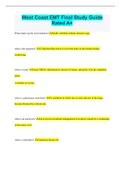Samenvatting
Summary Physiotherapeutic Theory and Practice
- Vak
- Instelling
Summary of all the lessons of physiotherapy theory for neurological rehabilitation with notes (some in dutch). With this summary I was able to obtain 14/20 on the exam.
[Meer zien]











